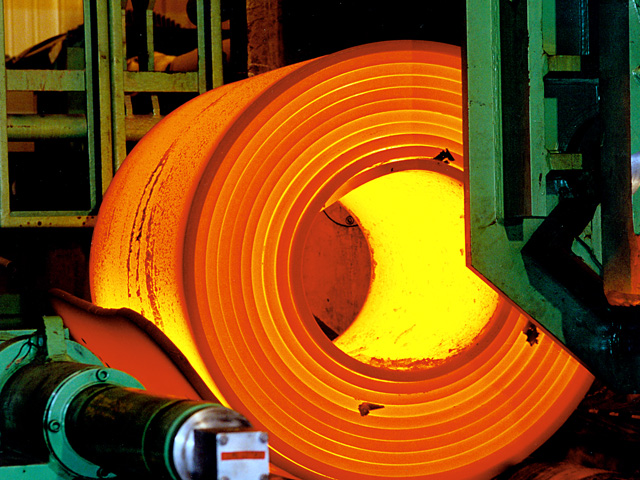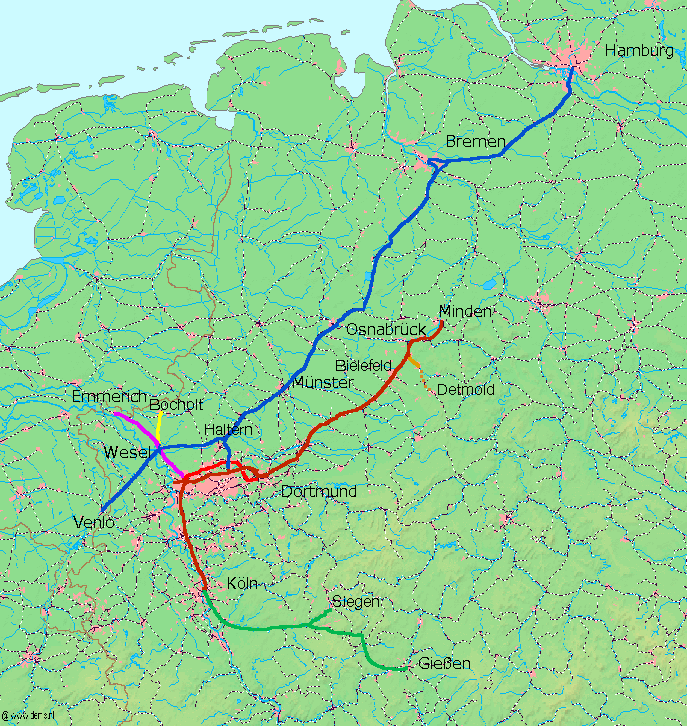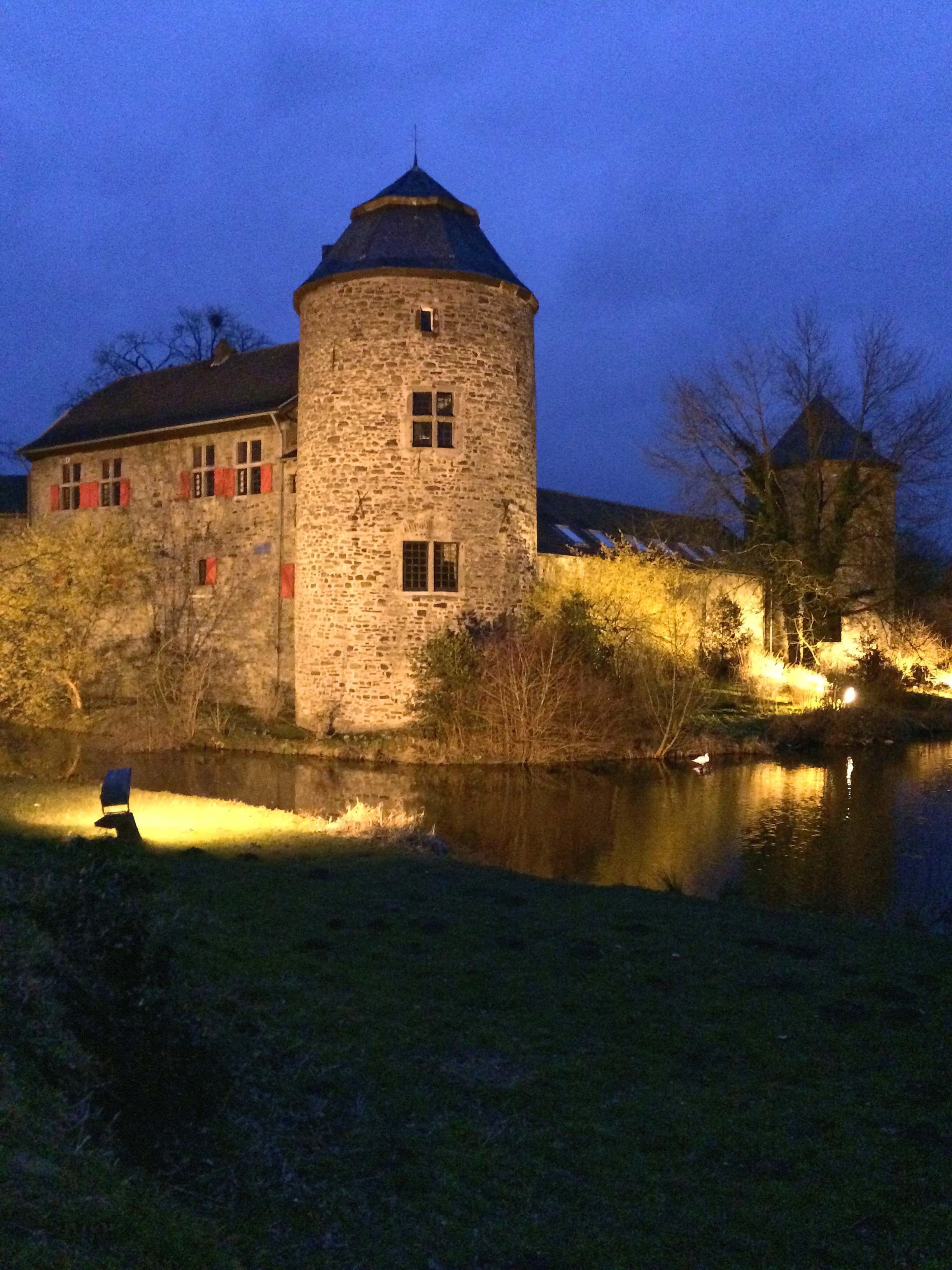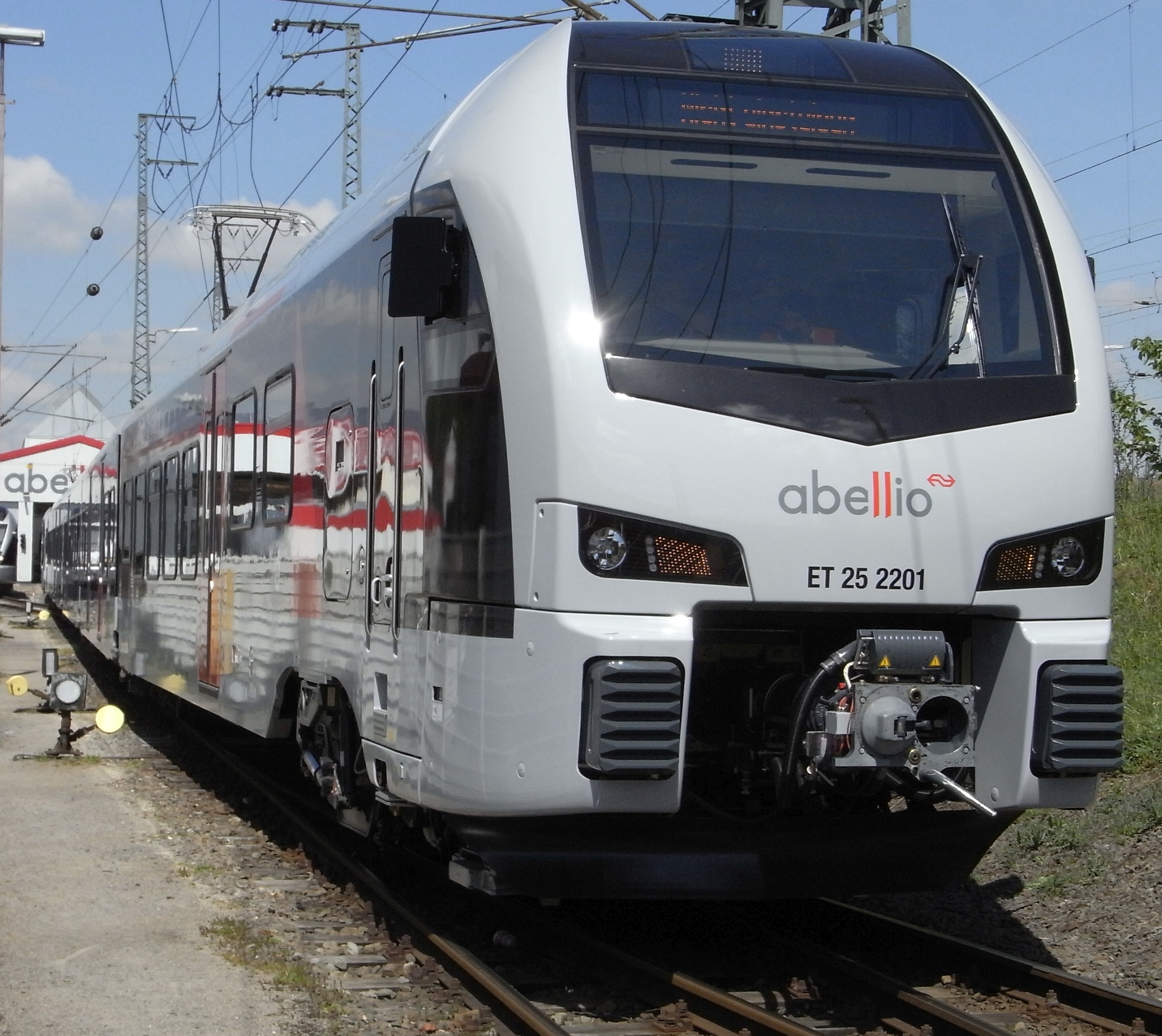|
Duisburg-Hochfeld Süd Station
Duisburg-Hochfeld Süd station is a station with a large area of rail tracks in Duisburg in the German state of North Rhine-Westphalia. It is connected to several important railway lines. In addition, several tracks connect to Duisburg Central Station and various industrial tracks connect with the station area. It is classified by Deutsche Bahn as a category 5 station. History On 23 August 1866, the Rhenish Railway Company (german: Rheinische Eisenbahn-Gesellschaft, RhE) put the section of the Osterath–Dortmund Süd railway from Hochfeld to ''Essen RhE'' station into operation. At the same time the train ferry from Rheinhausen was put into operation. On 1 September 1866 the then ''Hochfeld (RhE)'' station was opened for passenger traffic. Hochfeld became the central railway station of three important RhE lines, the Osterath–Dortmund Süd railway, the Troisdorf–Mülheim-Speldorf railway and the Duisburg–Quakenbrück railway, which also connect with numerous short routes ... [...More Info...] [...Related Items...] OR: [Wikipedia] [Google] [Baidu] |
Duisburg-Hochfeld Railway Bridge
The Duisburg–Hochfeld railway bridge (german: Duisburg-Hochfelder Eisenbahnbrücke) spans the Rhine in the German city of Duisburg on the Duisburg-Ruhrort–Mönchengladbach line. The first bridge was built by the Rhenish Railway Company and put into operation at the end of 1873. It was replaced by a new bridge in 1927, which was badly damaged during the Second World War, but rebuilt and is still serves rail traffic between the Ruhr region and Aachen. History On 23 August 1866, the Rhenish Railway Company (''Rheinische Eisenbahn-Gesellschaft'', RhE) opened its line between Osterrath and Essen to connect the coal mines in the Ruhr region with its railway network, which at that time was mainly located on the west bank of the Rhine. This line included the Rheinhausen–Hochfeld train ferry. Prior to the Austro-Prussian War, the Prussian military opposed the building of fixed bridges across the Rhine for military reasons, except in fortified cities such as Cologne, Mainz, ... [...More Info...] [...Related Items...] OR: [Wikipedia] [Google] [Baidu] |
Rheinhausen–Hochfeld Train Ferry
The Rheinhausen–Hochfeld train ferry was a German train ferry on the Rhine between Rheinhausen and Hochfeld, now districts of Duisburg. It was built by the Rhenish Railway Company and commenced operations on 23 August 1866. History Following the development of railways on the left bank (the part of the 19th century Prussian Rhine Province that was west of the Rhine) from Cologne to Kleve (the West Lower Rhine line), Aachen (the Cologne–Aachen line) and Bingerbrück (the West Rhine railway ) by the Rhenish Railway Company (''Rheinische Eisenbahn-Gesells''chaft, RhE) investigated, under its President, Gustav von Mevissen, a rail connection to serve the coal mines in the Ruhr district. The very lucrative coal traffic there was then only served by the Cologne-Minden Railway Company (''Cöln-Mindener Eisenbahn-Gesellschaft'', CME) and the Bergisch-Märkische Railway Company (''Bergisch-Märkische Eisenbahn-Gesellschaft'', BME). Construction of the train ferry operation Planning ... [...More Info...] [...Related Items...] OR: [Wikipedia] [Google] [Baidu] |
Mannesmann
Mannesmann was a German industrial conglomerate. It was originally established as a manufacturer of steel pipes in 1890 under the name "Deutsch-Österreichische Mannesmannröhren-Werke AG". (Loosely translated: "German-Austrian Mannesmann pipe mills AG"). In the twentieth century, Mannesmann's product range grew and the company expanded into numerous sectors; starting from various steel products and trading to mechanical and electrical engineering, automotive and telecommunications. From 1955, the conglomerate's management holding with headquarters in Düsseldorf was named Mannesmann AG. The particular success of the corporate activities in the area of telecommunications that started in 1990 was the predominant reason for the takeover of Mannesmann by the British telecommunications company Vodafone in 2000, still one of the largest-ever company takeovers worldwide. Back then, the Mannesmann Group had 130,860 employees worldwide and revenues of €23.27 billion. The name Man ... [...More Info...] [...Related Items...] OR: [Wikipedia] [Google] [Baidu] |
ThyssenKrupp
ThyssenKrupp AG (, ; stylized as thyssenkrupp) is a German industrial engineering and steel production multinational conglomerate. It is the result of the 1999 merger of Thyssen AG and Krupp and has its operational headquarters in Duisburg and Essen. The company claims to be one of the world's largest steel producers, and it was ranked tenth-largest worldwide by revenue in 2015."The world's largest steel companies in 2015, based on revenue" ''Statista'' It is divided into 670 subsidiaries worldwide. The largest shareholders are Alfried Krupp von Bohlen und Halbach Fo ... [...More Info...] [...Related Items...] OR: [Wikipedia] [Google] [Baidu] |
ArcelorMittal
ArcelorMittal S.A. is a Luxembourgian multinational steel manufacturing corporation headquartered in Luxembourg City. It was formed in 2006 from the takeover and merger of Arcelor by Indian-owned Mittal Steel. ArcelorMittal is the second largest steel producer in the world, with an annual crude steel production of 88 million metric tonnes . It is ranked 197th in the 2022 Fortune Global 500 ranking of the world's largest corporations. It employs directly and indirectly 200,000 people and its market capital is $25 billion. The total value of company assets is estimated to be around $100 billion. Products and activities The company is involved in research and development, mining, and steel. ArcelorMittal in 2016 produced around 90 million tons of steel. As of May 2017, the company made 200 unique steel grades for automotive purposes, half of which were introduced since 2007. Among the steel varieties are Usibor 2000, which the company announced in June 2016 and released later ... [...More Info...] [...Related Items...] OR: [Wikipedia] [Google] [Baidu] |
Cologne-Minden Railway Company
The Cologne-Minden Railway Company (German, old spelling: ''Cöln-Mindener Eisenbahn-Gesellschaft'', ''CME'') was along with the Bergisch-Märkische Railway Company and the Rhenish Railway Company one of the railway companies that in the mid-19th century built the first railways in the Ruhr and large parts of today's North Rhine-Westphalia. Founding The founding of the Cologne-Minden Railway Company in 1843 in Cologne ended a long struggle for a railway line between the Rhineland and the German North Sea ports, as well as the Prussian capital of Berlin. From the 1830s several railway committees in the cities of Düsseldorf, Cologne and Aachen attempted to find a solution with each other and the Prussian government. The focus of all these efforts was to avoid the Dutch duties on trade on the Rhine, which significantly increased the cost of import and export of goods via the Rhine. Some of the Cologne committee members under David Hansemann (1790–1864)—a merchant and banker ... [...More Info...] [...Related Items...] OR: [Wikipedia] [Google] [Baidu] |
Düsseldorf Central Station
Düsseldorf ( , , ; often in English sources; Low Franconian and Ripuarian: ''Düsseldörp'' ; archaic nl, Dusseldorp ) is the capital city of North Rhine-Westphalia, the most populous state of Germany. It is the second-largest city in the state and the seventh-largest city in Germany, with a population of 617,280. Düsseldorf is located at the confluence of two rivers: the Rhine and the Düssel, a small tributary. The ''-dorf'' suffix means "village" in German (English cognate: ''thorp''); its use is unusual for a settlement as large as Düsseldorf. Most of the city lies on the right bank of the Rhine. Düsseldorf lies in the centre of both the Rhine-Ruhr and the Rhineland Metropolitan Region. It neighbours the Cologne Bonn Region to the south and the Ruhr to the north. It is the largest city in the German Low Franconian dialect area (closely related to Dutch). Mercer's 2012 Quality of Living survey ranked Düsseldorf the sixth most livable city in the world. Düsse ... [...More Info...] [...Related Items...] OR: [Wikipedia] [Google] [Baidu] |
Ratingen
Ratingen ( li, Rotinge) is a town in the district of Mettmann in North Rhine-Westphalia, Germany. It lies in the northwestern part of Berg about 12 km northeast of Düsseldorf. Administration With a communal reform of 1975 the independent municipalities of Breitscheid, Eggerscheidt, Hösel, Lintorf (seat Angerland) as well as the local part of Homberg and the municipality of Homberg-Meiersberg (seat Hubbelrath) were added into the city of Ratingen. History Ratingen was settled before 849. Since the Middle Ages, the Ratingen area belonged to the count and later dukes of Berg. On December 11, 1276 the settlement received city rights. Ratingen was one of the four places of Berg which experienced an economic boom in the end of the Middle Ages, but slowed during the Thirty Years' War. At the beginning of the Industrial Age, the first manufacturing plants opened in 1783. In Cromford the first mechanical spinnery of Europe opened, which grew into the '' Textilfabrik Cromfor ... [...More Info...] [...Related Items...] OR: [Wikipedia] [Google] [Baidu] |
Duisburg-Entenfang Station
Duisburg-Entenfang is a railway station in southern Duisburg, Germany Germany,, officially the Federal Republic of Germany, is a country in Central Europe. It is the second most populous country in Europe after Russia, and the most populous member state of the European Union. Germany is situated betwe .... The station was opened in 1982 and closed on December 15, 2019. The station lies on the eastern side of the freight sidings on the freight-only line to Düsseldorf. It is situated next to a small lake, after which the station is named. The single track ends in a buffer stop just a few metres shy of the platform end. P ... [...More Info...] [...Related Items...] OR: [Wikipedia] [Google] [Baidu] |
Mülheim Central Station
Mülheim, officially Mülheim an der Ruhr () and also described as ''"City on the River"'', is a city in North Rhine-Westphalia in Germany. It is located in the Ruhr Area between Duisburg, Essen, Oberhausen and Ratingen. It is home to many companies, especially in the food industry, such as the Aldi Süd Company, the Harke Group and the Tengelmann Group. Mülheim received its town charter in 1808, and 100 years later the population exceeded 100,000, making Mülheim officially a city. At the time of the city's 200th anniversary with approximately 170,000 residents, it was counted among the smaller cities of Germany. Geography Geographical location Mülheim an der Ruhr is located to the southwest of Essen in the Ruhr valley. Geology The northern foothills of the Rhenish Massif are characterised by the distinctive rock formation of the bare mountain slopes through which run coal-bearing layers which formed during the carboniferous period. Here the Ruhr cuts more than 50 meter ... [...More Info...] [...Related Items...] OR: [Wikipedia] [Google] [Baidu] |
Emscher-Niederrhein-Bahn
The Emscher-Niederrhein-Bahn (RB 35) is a Regionalbahn service in the German state of North Rhine-Westphalia. It runs hourly between Gelsenkirchen and Duisburg with Mönchengladbach. Its name refers to the Emscher river (which runs near Duisburg and Gelsenkirchen) and the Lower Rhine (which the service crosses between Duisburg-Hochfeld Süd and Rheinhausen-Ost). History Before 2016, there was already a service numbered as RB 35, operating under the name of ''Der Weseler''. It ran mainly between Wesel and Duisburg Hbf and was extended during the peak hour from Duisburg to Düsseldorf and once a day to Cologne, as well as from Wesel to Emmerich and it thus functioned to relieve the Rhein-Express (RE 5). From the timetable change of 2016, the route was extended beyond Duisburg to Mönchengladbach, which complemented the northern section of the Rhein-Niers-Bahn. The RE 5 was shortened to run on the Wesel–Duisburg–Düsseldorf–Köln–Bonn–Koblenz section ... [...More Info...] [...Related Items...] OR: [Wikipedia] [Google] [Baidu] |
Rhein-Niers-Bahn
The Rhine-Niers-Bahn (List of regional railway lines in North Rhine-Westphalia, RB 33) is a Regionalbahn service in the German state of North Rhine-Westphalia. It connects Essen Hauptbahnhof, Essen Hbf, Duisburg Hauptbahnhof, Duisburg Hbf on the Rhine with Mönchengladbach Hauptbahnhof, Mönchengladbach on the Niers, Aachen Hauptbahnhof, Aachen and Heinsberg (sections of List of scheduled railway routes in Germany, timetable routes 420, 425 and 485). Operations The service runs every hour between Essen and Aachen. In Lindern station between Mönchengladbach and Aachen, trains running from Aachen are uncoupled. The front section of the train continues as before running towards Mönchengladbach, while the rear section of the train is uncoupled and reverses to run towards Heinsberg. On the way back it is again coupled with a set coming from Mönchengladbach and continues as a coupled set towards Aachen. DBAG Class 425, Class 425 and DBAG Class 425, class 426 electric multiple uni ... [...More Info...] [...Related Items...] OR: [Wikipedia] [Google] [Baidu] |










